About Sarson Ka Saag
Sarson is the Hindi/Punjabi word for mustard and saag means greens; thus, this recipe is for the traditional Indian preparation of mustard greens. Other versions of saag include: Palak Saag (spinach greens), bathua saag, or Chane ka Saag (chickpea greens). Sarson ka saag is a type of curry, so it is creamy, saucy and simply addictive. Traditionally, it is served with an unleavened corn-based flatbread known as Makki di Roti, though it can also be served with Paratha and steamed basmati rice. This sarson ka saag recipe is a labor of love, requiring both time and patience. Unfortunately, there is no shortcut method for making this dish. You’ll need to sort the greens, then wash, chop, and cook them before blending them, after which you’ll need to cook them again. It is a labor-intensive process, but none of the steps are difficult. While I’m aware that everyone wants their curry in a hurry nowadays, if you really want to savor the taste of an authentic sarson da saag then you’ll have to invest some time in preparing it. The sarson ka saag recipe is very easy, but does take a lot of time to make; as such I like to break up the steps over the course of a few days. Usually, I clean the greens one day before and keep them in the fridge in airtight containers so half of the work is over. Making the saag the following day makes it feel much easier. At home, we generally use 5 different leafy green vegetables to make the saag. They are: You can see all the greens (with the exception of methi) in the photo below. The predominant flavor in this saag recipe comes from the spicy, bitter mustard greens. The presence of spinach, bathua, and radish helps to lessen the bitterness of the mustard and methi so you end up with a creamy, mellow saag that is simply bursting with flavor. Winter is the season for both mustard and bathua here in India. Sarson ka saag is therefore considered a cold-weather dish in North India, especially in Punjab from where this traditional recipe comes from. The sarson da saag is usually topped with Homemade Butter and served with makki ki roti (flat breads from maize flour); this meal is not only comforting but also serves to warm up the palate and body. With all of the dark, leafy greens, sarson ka saag is a bowlful of antioxidants and phytonutrients, so that extra topping of butter is alright. The saag is also usually served with an accompaniment of sliced or chopped onions and some green chilies for some extra piquancy. Because this is a time-intensive recipe, I always make sarson ka saag in bulk and keep it in the fridge. Then, when I need to serve it, all I have to do is temper the saag and then enjoy! From what I have observed, the taste of the saag improves after about a day; all of the flavors meld as it ages. Mine usually does not last for more than 4 to 5 days, after which you can freeze any leftovers.
Saag Proportions
The recipe I present here is the traditional way we make saag at home. The proportion of bathua to spinach and mustard is 1:1:2. So for example, if you are using 1 whole bunch of mustard leaves then use a ½ bunch of bathua and a ½ bunch of spinach. You can also consider using this ratio in cup measurement. Example for 2 cups of mustard greens use one cup each of spinach and bathua. Note that you can easily increase or decrease this ratio proportionately. The other two greens – radish and fenugreek – are added using the Indian method of andaaz, which means we just eyeball it. Fenugreek is optional, though I love the flavor and health benefits it brings to this cozy winter meal. This sarson ka saag recipe makes roughly 8 to 9 servings, but it can be easily halved or doubled.
How to make Sarson ka Saag
Prep, chop and clean all the greens
1: Remove the lower end of the mustard seems just a few centimeters from the base. The mustard stems can be tough, so it is up to you whether you want to discard the stems or keep them. If you keep them, then they have to be cooked really well so that they become soft. Sort and prep the remaining greens as well – spinach, bathua, fenugreek leaves. For the radish, sort the leaves and peel, chop the root. If prepping ahead a day earlier, refrigerate the greens and the radish root in ziplock bags or air-tight containers for a day. You will need the following leafy greens:
1 bunch of mustard greens – cleaned & sorted½ bunch of bathua or a small bunch½ bunch of spinach or a small to medium-sized bunch1 cup chopped tender radish greens1 cup fenugreek leaves – optional3 to 4 inches white radish root
Rinse Greens
2: This is perhaps the most time-intensive part of the process. You have to really wash the greens – especially the mustard greens – to get rid of the mud clinging to the stems. Depending on the size of your sink, you may need to do this task in batches. Note that the prep up to this point can be done up to 1 to 2 days in advance; keep the prepped greens in the fridge until you are ready to rinse the greens and then make the saag. Do not rinse the greens and store them in the fridge – they will rot.
Pressure Cook
3: Add the greens to a 5 or 6 litre stove-top pressure cooker. 4: Add the other veggies – peeled and chopped radish root (2 to 3 inches), 1 cup chopped onions, 1.5 cups chopped tomatoes, 2 inches ginger (chopped) and 7 to 8 medium-sized garlic (chopped). 5: Season the greens using 2 green chilies (chopped), ½ teaspoon red chili powder, 2 to 3 pinches asafoetida (hing) & salt as needed. 6: Add 2 to 3 cups water. 7: Cover and pressure cook for 6 to 7 minutes on medium-high heat, or until the greens become soft. Wait for the pressure to fall naturally in the cooker and then only open the lid. You can also cook in a pan, though it will take longer. Cover and let the greens cook till they become soft. 8: Let the pressure settle naturally in the cooker. When you open the lid, you will see the greens, onions, tomatoes etc all have cooked well. Let the greens mixture cool to room temperature.
Blend The Greens
9: Add some of the greens and their cooking liquid to the base of a blender.
10: Add 2 tablespoons of maize flour (fine cornmeal).
11: Working in batches, blend to your preferred consistency. I usually make a smooth puree, but some folks like a coarser texture.
You can also use a hand blender to minimize the number of dishes. If doing so, then chop the greens before you pressure cook them to make them easier to blend. The traditional way is to use a Madani (Indian hand blender) to blend the greens.
Cook The Pureed Sarson ka Saag
12: Pour the greens purée in a deep-sided pot, as it will bubble and splutter. You can also add it to the same cooker. 13: Simmer for a good 25 to 30 minutes. Stir occasionally so that the sarson da saag does not stick to the bottom of the pan. Check the seasonings and add more salt if required. Once cooled, the saag can be kept in an airtight container in the fridge for 4 to 5 days.
Make Tempering
14: The saag is not ready to be served yet – we still have to temper it. We always temper the saag with onions, but you can also add some ginger, green chilies and tomatoes along with the onions. Heat oil or ghee and add aromatics. The amount of oil/ghee and onions to be added depends on the portions of saag you will be serving. For 3 servings, 1 to 2 tablespoons of oil with 1 medium-sized onion (about one-third cup finely chopped onions) is about right. 15: Lightly brown the onions. 16: Add about 2 cups of the cooked sarson ka saag to the tempering. Simmer for a few minutes until the saag becomes hot. 17: Serve the hot sarson ka saag straight away, preferably with makki di roti and a few jaggery cubes by the side – nothing beats this combination. You can also serve sarson da saag with paratha and steamed rice. Pair this meal combination of the saag and makki ki roti with a side of freshly chopped onions and green chilies if you like. Please be sure to rate the recipe in the recipe card or leave a comment below if you have made it. For more vegetarian inspirations, Sign Up for my emails or follow me on Instagram, Youtube, Facebook, Pinterest or Twitter. Palak Paneer Recipe (Spinach & Paneer Cheese Curry) Aloo Palak | Spinach Curry with Potatoes Bhindi Masala Recipe (Punjabi Style) Aloo Methi Recipe This Sarson ka Saag recipe post from the archives, first published on December 2012 has been republished and updated on November 2022.
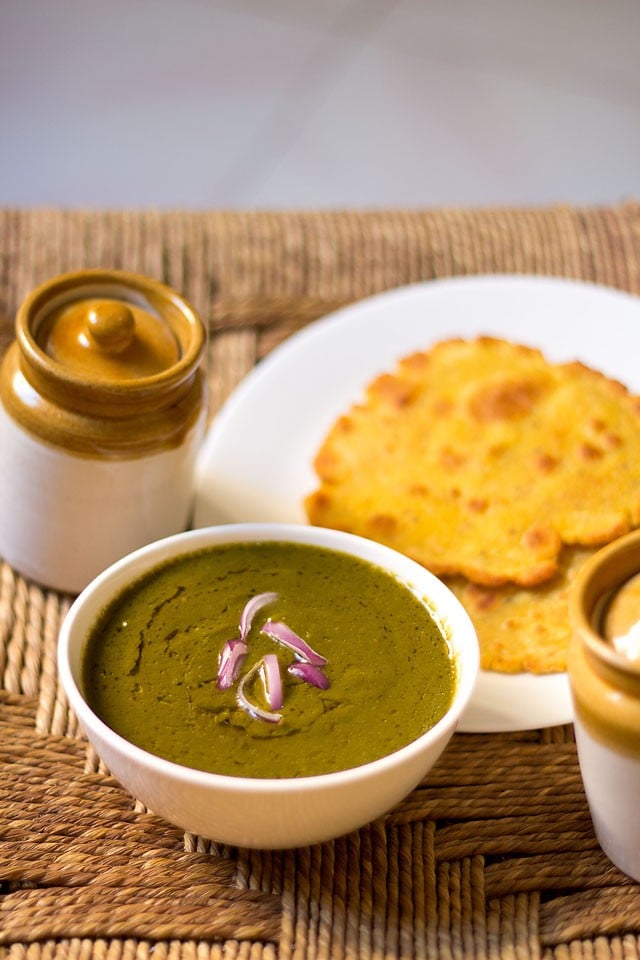
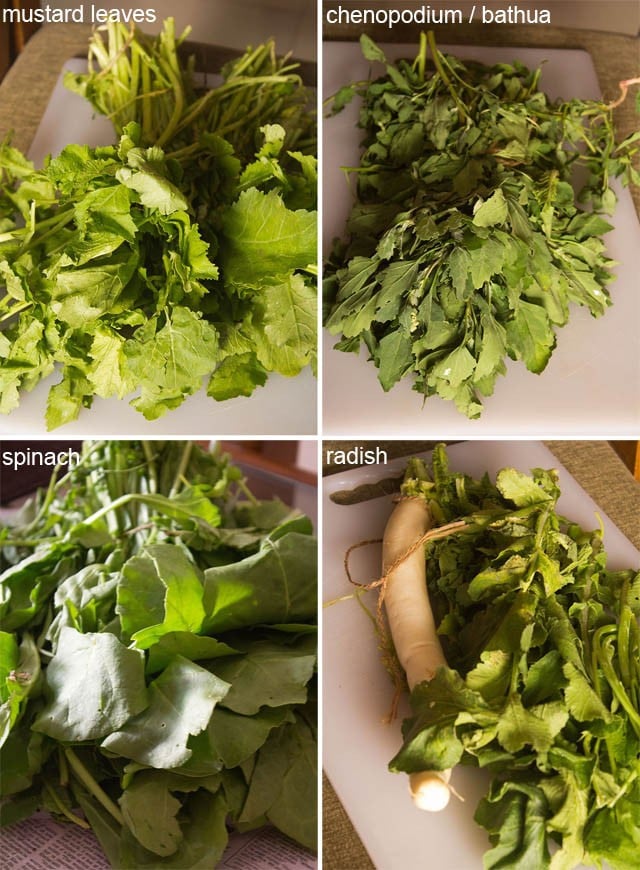
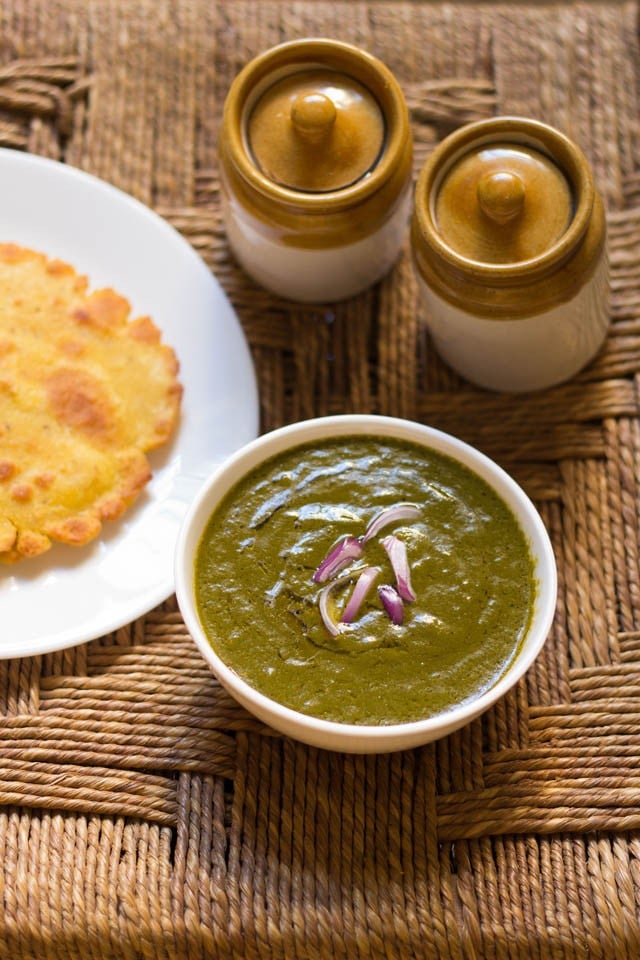
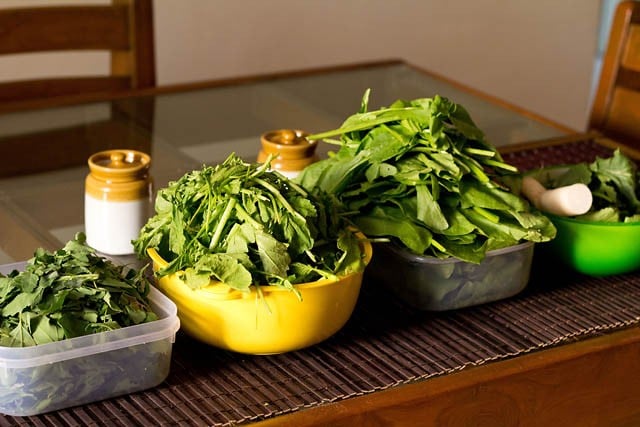
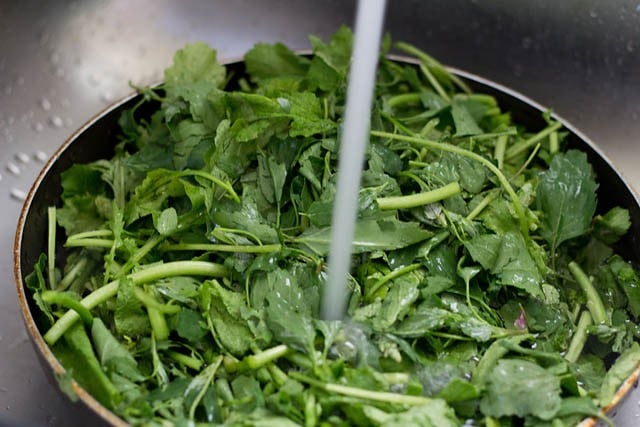
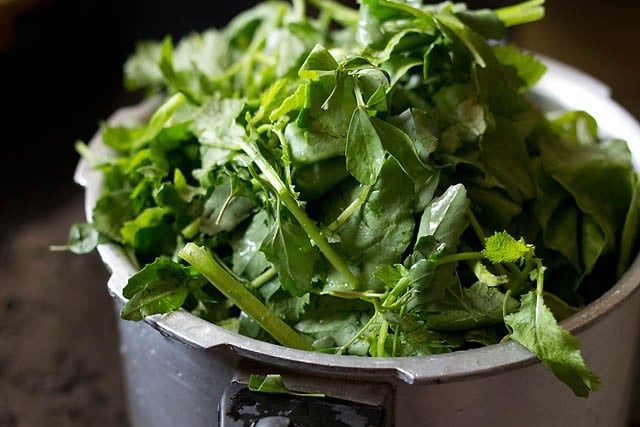
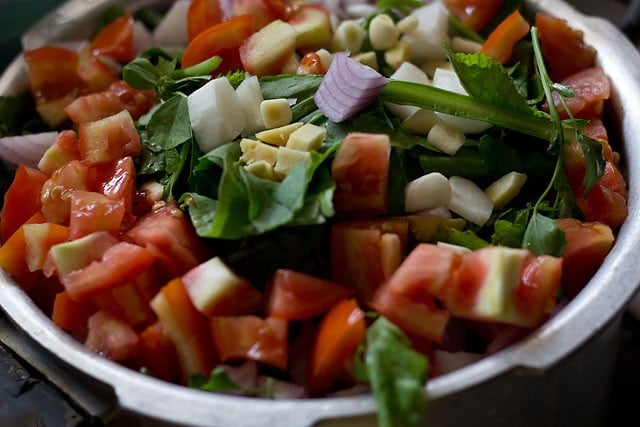
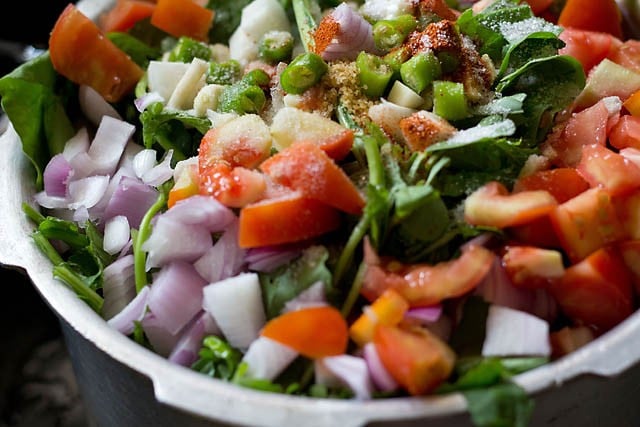
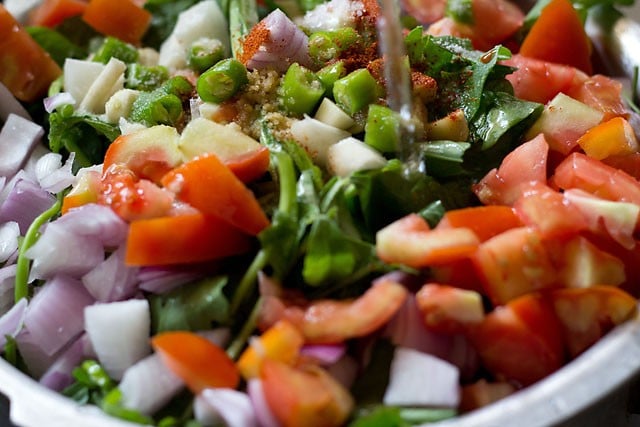
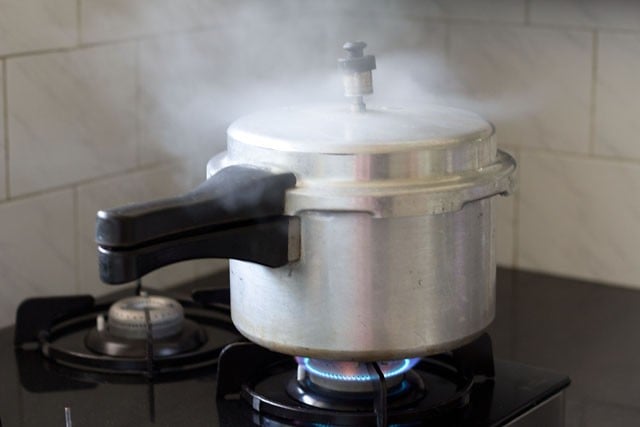
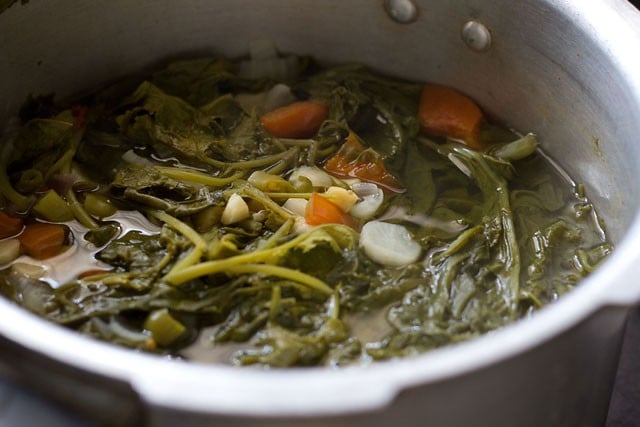

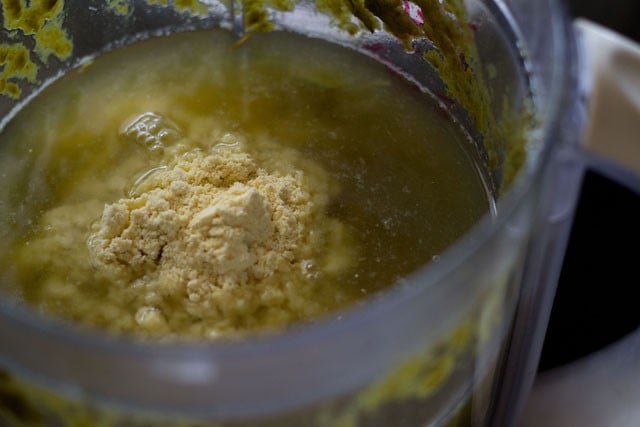
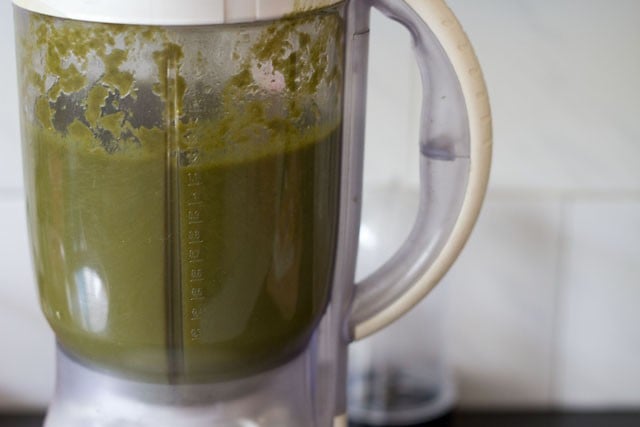
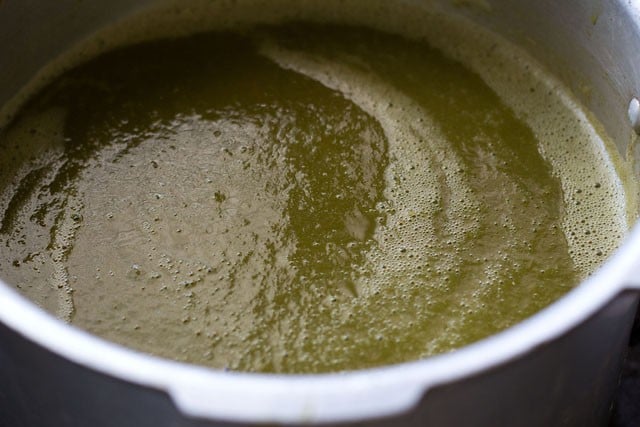
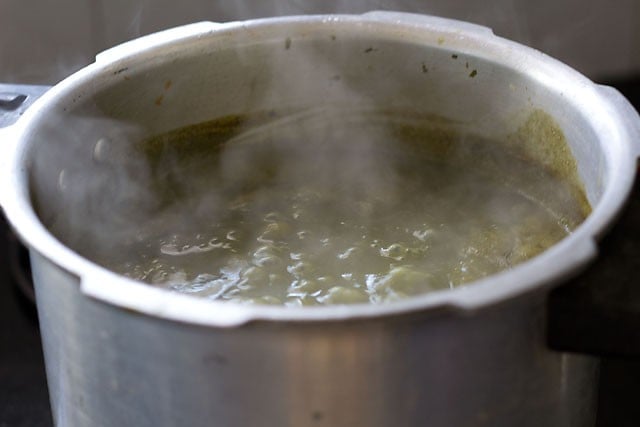
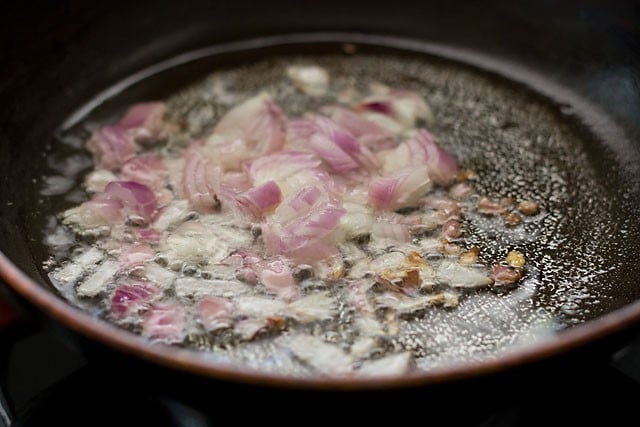
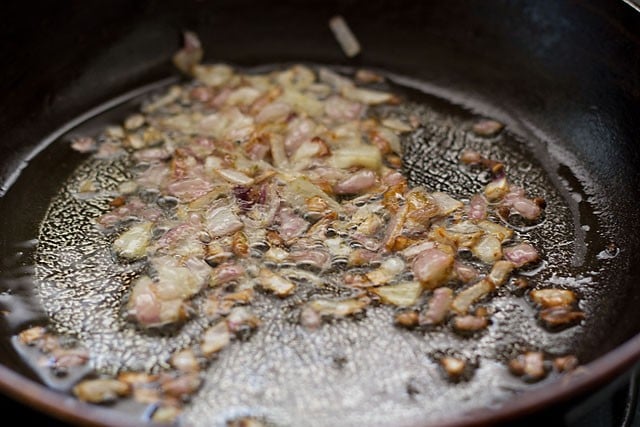
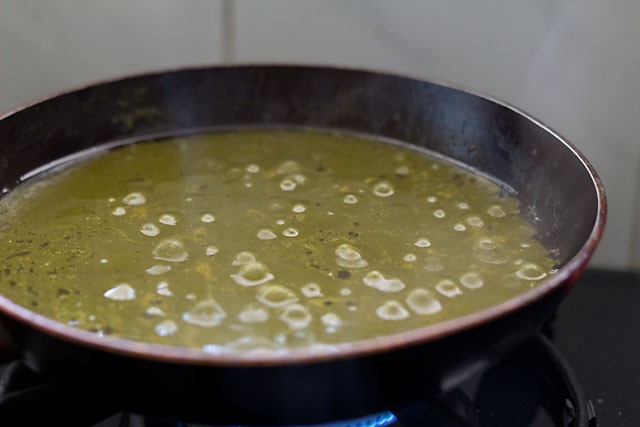



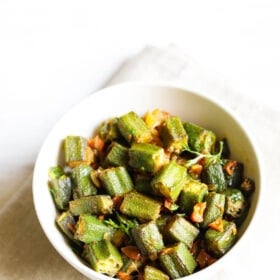
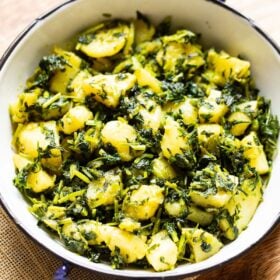
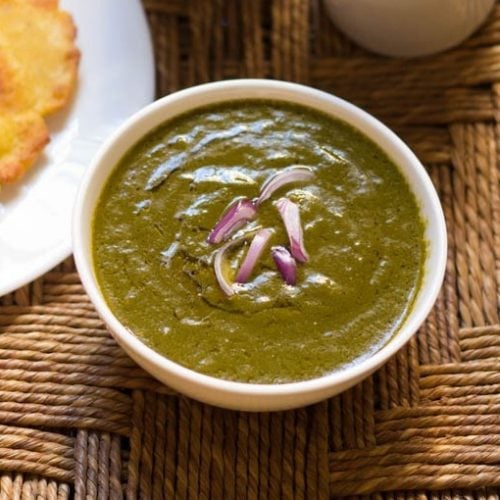
title: “Sarson Ka Saag Authentic Punjabi Sarson Da Saag” ShowToc: true date: “2024-10-09” author: “Deborah Marble”
About Sarson Ka Saag
Sarson is the Hindi/Punjabi word for mustard and saag means greens; thus, this recipe is for the traditional Indian preparation of mustard greens. Other versions of saag include: Palak Saag (spinach greens), bathua saag, or Chane ka Saag (chickpea greens). Sarson ka saag is a type of curry, so it is creamy, saucy and simply addictive. Traditionally, it is served with an unleavened corn-based flatbread known as Makki di Roti, though it can also be served with Paratha and steamed basmati rice. This sarson ka saag recipe is a labor of love, requiring both time and patience. Unfortunately, there is no shortcut method for making this dish. You’ll need to sort the greens, then wash, chop, and cook them before blending them, after which you’ll need to cook them again. It is a labor-intensive process, but none of the steps are difficult. While I’m aware that everyone wants their curry in a hurry nowadays, if you really want to savor the taste of an authentic sarson da saag then you’ll have to invest some time in preparing it. The sarson ka saag recipe is very easy, but does take a lot of time to make; as such I like to break up the steps over the course of a few days. Usually, I clean the greens one day before and keep them in the fridge in airtight containers so half of the work is over. Making the saag the following day makes it feel much easier. At home, we generally use 5 different leafy green vegetables to make the saag. They are: You can see all the greens (with the exception of methi) in the photo below. The predominant flavor in this saag recipe comes from the spicy, bitter mustard greens. The presence of spinach, bathua, and radish helps to lessen the bitterness of the mustard and methi so you end up with a creamy, mellow saag that is simply bursting with flavor. Winter is the season for both mustard and bathua here in India. Sarson ka saag is therefore considered a cold-weather dish in North India, especially in Punjab from where this traditional recipe comes from. The sarson da saag is usually topped with Homemade Butter and served with makki ki roti (flat breads from maize flour); this meal is not only comforting but also serves to warm up the palate and body. With all of the dark, leafy greens, sarson ka saag is a bowlful of antioxidants and phytonutrients, so that extra topping of butter is alright. The saag is also usually served with an accompaniment of sliced or chopped onions and some green chilies for some extra piquancy. Because this is a time-intensive recipe, I always make sarson ka saag in bulk and keep it in the fridge. Then, when I need to serve it, all I have to do is temper the saag and then enjoy! From what I have observed, the taste of the saag improves after about a day; all of the flavors meld as it ages. Mine usually does not last for more than 4 to 5 days, after which you can freeze any leftovers.
Saag Proportions
The recipe I present here is the traditional way we make saag at home. The proportion of bathua to spinach and mustard is 1:1:2. So for example, if you are using 1 whole bunch of mustard leaves then use a ½ bunch of bathua and a ½ bunch of spinach. You can also consider using this ratio in cup measurement. Example for 2 cups of mustard greens use one cup each of spinach and bathua. Note that you can easily increase or decrease this ratio proportionately. The other two greens – radish and fenugreek – are added using the Indian method of andaaz, which means we just eyeball it. Fenugreek is optional, though I love the flavor and health benefits it brings to this cozy winter meal. This sarson ka saag recipe makes roughly 8 to 9 servings, but it can be easily halved or doubled.
How to make Sarson ka Saag
Prep, chop and clean all the greens
1: Remove the lower end of the mustard seems just a few centimeters from the base. The mustard stems can be tough, so it is up to you whether you want to discard the stems or keep them. If you keep them, then they have to be cooked really well so that they become soft. Sort and prep the remaining greens as well – spinach, bathua, fenugreek leaves. For the radish, sort the leaves and peel, chop the root. If prepping ahead a day earlier, refrigerate the greens and the radish root in ziplock bags or air-tight containers for a day. You will need the following leafy greens:
1 bunch of mustard greens – cleaned & sorted½ bunch of bathua or a small bunch½ bunch of spinach or a small to medium-sized bunch1 cup chopped tender radish greens1 cup fenugreek leaves – optional3 to 4 inches white radish root
Rinse Greens
2: This is perhaps the most time-intensive part of the process. You have to really wash the greens – especially the mustard greens – to get rid of the mud clinging to the stems. Depending on the size of your sink, you may need to do this task in batches. Note that the prep up to this point can be done up to 1 to 2 days in advance; keep the prepped greens in the fridge until you are ready to rinse the greens and then make the saag. Do not rinse the greens and store them in the fridge – they will rot.
Pressure Cook
3: Add the greens to a 5 or 6 litre stove-top pressure cooker. 4: Add the other veggies – peeled and chopped radish root (2 to 3 inches), 1 cup chopped onions, 1.5 cups chopped tomatoes, 2 inches ginger (chopped) and 7 to 8 medium-sized garlic (chopped). 5: Season the greens using 2 green chilies (chopped), ½ teaspoon red chili powder, 2 to 3 pinches asafoetida (hing) & salt as needed. 6: Add 2 to 3 cups water. 7: Cover and pressure cook for 6 to 7 minutes on medium-high heat, or until the greens become soft. Wait for the pressure to fall naturally in the cooker and then only open the lid. You can also cook in a pan, though it will take longer. Cover and let the greens cook till they become soft. 8: Let the pressure settle naturally in the cooker. When you open the lid, you will see the greens, onions, tomatoes etc all have cooked well. Let the greens mixture cool to room temperature.
Blend The Greens
9: Add some of the greens and their cooking liquid to the base of a blender.
10: Add 2 tablespoons of maize flour (fine cornmeal).
11: Working in batches, blend to your preferred consistency. I usually make a smooth puree, but some folks like a coarser texture.
You can also use a hand blender to minimize the number of dishes. If doing so, then chop the greens before you pressure cook them to make them easier to blend. The traditional way is to use a Madani (Indian hand blender) to blend the greens.
Cook The Pureed Sarson ka Saag
12: Pour the greens purée in a deep-sided pot, as it will bubble and splutter. You can also add it to the same cooker. 13: Simmer for a good 25 to 30 minutes. Stir occasionally so that the sarson da saag does not stick to the bottom of the pan. Check the seasonings and add more salt if required. Once cooled, the saag can be kept in an airtight container in the fridge for 4 to 5 days.
Make Tempering
14: The saag is not ready to be served yet – we still have to temper it. We always temper the saag with onions, but you can also add some ginger, green chilies and tomatoes along with the onions. Heat oil or ghee and add aromatics. The amount of oil/ghee and onions to be added depends on the portions of saag you will be serving. For 3 servings, 1 to 2 tablespoons of oil with 1 medium-sized onion (about one-third cup finely chopped onions) is about right. 15: Lightly brown the onions. 16: Add about 2 cups of the cooked sarson ka saag to the tempering. Simmer for a few minutes until the saag becomes hot. 17: Serve the hot sarson ka saag straight away, preferably with makki di roti and a few jaggery cubes by the side – nothing beats this combination. You can also serve sarson da saag with paratha and steamed rice. Pair this meal combination of the saag and makki ki roti with a side of freshly chopped onions and green chilies if you like. Please be sure to rate the recipe in the recipe card or leave a comment below if you have made it. For more vegetarian inspirations, Sign Up for my emails or follow me on Instagram, Youtube, Facebook, Pinterest or Twitter. Palak Paneer Recipe (Spinach & Paneer Cheese Curry) Aloo Palak | Spinach Curry with Potatoes Bhindi Masala Recipe (Punjabi Style) Aloo Methi Recipe This Sarson ka Saag recipe post from the archives, first published on December 2012 has been republished and updated on November 2022.
























